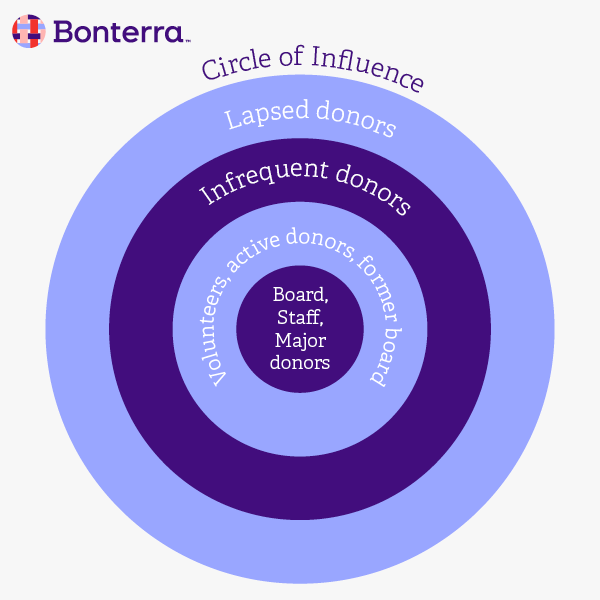Aside from your nonprofit organization’s executive directors, who are the most important fundraisers for your organization? If you immediately thought about your board members, you’re right!
While your board members understand the importance of fundraising for your nonprofit’s fiscal health, they may not always be directly involved in the process. Luckily, there’s plenty you can do to engage them more directly as fundraisers, starting by educating them about the process.
Educate your board members on fundraising strategies
Consider asking for some time at an upcoming board meeting to provide the board with an overview of your nonprofit’s existing fundraising strategy. The best way to engage board members is to break down your organization’s strategies into manageable pieces and explain where they might assist.
For example, you might show your board a graphic to explain your nonprofit’s circle of influence:

Using this graphic, you can explain how a prospective donor usually begins outside the largest circle and that it is a fundraiser’s job to get them to the inner circle, where the board and stakeholders are. The closer donors get to the inner circle, the more likely they are to give (and give in larger amounts with every move closer!).
Then, explain how they can help move prospects and donors inward using fundraising strategies, such as the “five I’s” of fundraising. These five I’s include:
- Identification: The first step is to identify prospective donors by doing prospect research or leveraging existing connections.
- Information: Collect information about the prospective donor and inform them about your nonprofit’s work and purpose.
- Interest: Next, gauge their interest in becoming a donor or getting involved with your organization in other ways. You can do this with one-on-one conversations, outreach, or surveys.
- Involvement: Once you determine their level of interest, invite them to get involved in a relevant way. Don’t be afraid to start small. One small action can lead to more with effective stewardship.
- Investment: All of these steps lead up to the moment when a donor decides to invest in your nonprofit by making their first gift.
Explain to the board that fundraising is about building and maintaining relationships, and this is where their work can make a difference! Board members can engage with prospects and donors during every step of this process through emails, calls, and personal invitations to events or volunteer opportunities. They can encourage gifts by using language like “join me in supporting our purpose” in phone calls or written appeals. A fundraising solution like Bonterra Network for Good helps make these kinds of outreach easy and authentic.
What if board members aren’t interested in fundraising?
Some board members may say they are not fundraisers or be hesitant to ask anyone for money. Respect attitudes around solicitation that are rooted in cultural, religious, or other values, but remind them that fundraising involves more than just making the ask. Encourage them to participate in the process so they can learn more, find roles they’re comfortable with, and ultimately help your organization grow.
6 ways to engage your board in fundraising
Start with these simple strategies to encourage more active engagement from your board members:
- Get them engaged in prospect cultivation and donor engagement long before the solicitation.
- Ask them to develop an elevator pitch about the organization, or write one for them. Collaborate with them to discover opportunities where they might come in contact with prospective donors so that they can share it.
- Ask if they would consider extending a personal invitation to a prospect for a volunteer event they are attending.
- Provide them with social media content about your organization that they can push out to their online networks, or ask them to create their own.
- Ask them to host a small dinner or cocktail party with the organization’s executive director and a few donor prospects.
- Finally, ask if they would be willing to accompany the executive director on a solicitation call.
The board member’s main responsibility is to pave the way for the executive director to make the ask. Have you heard the expression that donors don’t give to causes, they give to people? Having a board member in the meeting provides credibility for the solicitation and improves your chances of success.
Promoting donor stewardship to board members
Finally, an essential aspect of donor acquisition and fundraising is stewardship. This is a task where board engagement can make a substantial impact. Encourage board members to assist stewardship efforts by:
- Making thank-you calls.
- Writing handwritten thank-you notes.
- Reaching out to donors who supported the organization.
If your board members have enthusiasm for your organization, their willingness to share their gratitude greatly impresses new and existing donors.
The board, which demonstrates its commitment to your organization through its service, should be a critical component of your fundraising strategy. Make sure you engage them every step of the way with manageable tasks that members are comfortable with. Who knows, you may develop a fundraising board that loves to make the ask!
Alyson Landers has held many positions around the nonprofit boardroom table and enjoys work that allows her to synthesize best practices into components customized for a particular organization. The challenge of board engagement has been a focus of her nonprofit career. You can connect with her on LinkedIn.
Ready to Get Started?




